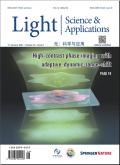High-speed all-optical neural networks empowered spatiotemporal mode multiplexing.
IF 23.4
Q1 OPTICS
引用次数: 0
Abstract
Orbital angular momentum (OAM) beams, characterized by a helical phase structure and phase singularity, have emerged as a powerful resource for high-capacity optical communications through mode-division multiplexing (MDM). Traditional OAM multiplexing systems operating solely in the spatial domain face significant challenges, including increased system complexity, inter-modal crosstalk, and limited scalability. Recent advances have explored hybrid multiplexing schemes combining OAM with wavelength or polarization degrees of freedom, demonstrating Pbit/s level transmission capacities. However, these systems predominantly rely on continuous-wave lasers and external modulators, which constrain their applicability in challenging environments, whereas pulsed lasers provide superior peak power, enhanced transmission robustness, and the potential for implementation of OAM lasers, which generally emit pulsed OAM beams. Here, we report an OAM-based spatiotemporal multiplexing (OAM-STM) technique that synergistically implements pulsed OAM beams with a diffractive deep neural network (D2NN) and optical fiber delay lines to project spatial mode information into the temporal domain. This approach leverages the full potential of pulsed laser sources by activating the underutilized time dimension, thereby overcoming the repetition-rate bottleneck and enhancing channel throughput. We experimentally demonstrate an OAM-based spatiotemporal demultiplexer achieving demultiplexing speed limited only by the bandwidth of the photodiode if OAM generation is fast enough. In the meantime, the architecture is intrinsically compatible with high-repetition-rate OAM sources, offering the entire system the scalability to GHz rates. This work establishes a foundational framework for high-speed, all-optical, and high-capacity OAM-STM systems, with promising implications for free-space optical communication, underwater communication links, and other complex environments.高速全光神经网络支持时空模式复用。
轨道角动量(OAM)光束具有螺旋相位结构和相位奇点的特点,已成为通过模分复用(MDM)实现高容量光通信的强大资源。传统的仅在空间域中运行的OAM多路复用系统面临着重大挑战,包括增加的系统复杂性、多模态串扰和有限的可扩展性。最近的进展探索了混合复用方案,将OAM与波长或偏振自由度结合起来,展示了Pbit/s级的传输能力。然而,这些系统主要依赖于连续波激光器和外部调制器,这限制了它们在具有挑战性的环境中的适用性,而脉冲激光器提供卓越的峰值功率,增强的传输鲁棒性,以及实现通常发射脉冲OAM光束的OAM激光器的潜力。在这里,我们报告了一种基于OAM的时空复用(OAM- stm)技术,该技术通过衍射深度神经网络(D2NN)和光纤延迟线协同实现脉冲OAM波束,将空间模式信息投射到时域。该方法通过激活未充分利用的时间维度,充分发挥了脉冲激光源的潜力,从而克服了重复率瓶颈,提高了信道吞吐量。我们通过实验证明了一种基于OAM的时空解复用器,如果OAM生成足够快,则可以实现仅受光电二极管带宽限制的解复用速度。同时,该体系结构与高重复率OAM源本质上兼容,为整个系统提供了GHz速率的可扩展性。这项工作为高速、全光和高容量OAM-STM系统建立了基础框架,对自由空间光通信、水下通信链路和其他复杂环境具有重要意义。
本文章由计算机程序翻译,如有差异,请以英文原文为准。
求助全文
约1分钟内获得全文
求助全文
来源期刊

Light-Science & Applications
数理科学, 物理学I, 光学, 凝聚态物性 II :电子结构、电学、磁学和光学性质, 无机非金属材料, 无机非金属类光电信息与功能材料, 工程与材料, 信息科学, 光学和光电子学, 光学和光电子材料, 非线性光学与量子光学
自引率
0.00%
发文量
803
审稿时长
2.1 months
 求助内容:
求助内容: 应助结果提醒方式:
应助结果提醒方式:


